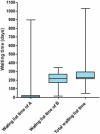Management of undescended testis may be improved with educational updates and new transferring model
- PMID: 29793548
- PMCID: PMC5968483
- DOI: 10.1186/s13052-018-0499-4
Management of undescended testis may be improved with educational updates and new transferring model
Abstract
Background: To investigate whether management of undescended testis (UDT) may be improved with educational updates and new transferring model among referring providers (RPs).
Methods: The age of orchidopexies performed in Children's Hospital of Chongqing Medical University were reviewed. We then proposed educational updates and new transferring model among RPs. The age of orchidopexies performed after our intervention were collected. Data were represented graphically and statistical analysis Chi-square for trend were used.
Results: A total of 1543 orchidopexies were performed. The median age of orchidopexy did not matched the target age of 6-12 months in any subsequent year. Survey of the RPs showed that 48.85% of their recommended age was below 12 months. However, only 25.50% of them would directly make a surgical referral to pediatric surgery specifically at this point. After we proposed educational updates, tracking the age of orchidopexy revealed a statistically significant trend downward.
Conclusions: The management of undescended testis may be improved with educational updates and new transferring model among primary healthcare practitioners.
Keywords: Age; Children; Educational updates; Orchidopexy; Undescended testis (UDT).
Conflict of interest statement
Ethics approval and consent to participate
Not applicable
Competing interests
The authors declare that they have no competing interests.
Publisher’s Note
Springer Nature remains neutral with regard to jurisdictional claims in published maps and institutional affiliations.
Figures


Similar articles
-
A 22-year retrospective study: educational update and new referral pattern of age at orchidopexy.BJU Int. 2016 Dec;118(6):987-993. doi: 10.1111/bju.13588. Epub 2016 Aug 28. BJU Int. 2016. PMID: 27430859
-
Management of undescended testis may be improved with educational updates for referring providers.J Pediatr Urol. 2014 Aug;10(4):707-11. doi: 10.1016/j.jpurol.2013.10.025. Epub 2013 Dec 1. J Pediatr Urol. 2014. PMID: 24368163
-
Shortcomings in the management of undescended testis: guideline intention vs reality and the underlying causes - insights from the biggest German cohort.BJU Int. 2018 Oct;122(4):644-653. doi: 10.1111/bju.14171. Epub 2018 Mar 9. BJU Int. 2018. PMID: 29451709
-
Age at orchidopexy as an indicator of the quality of regional child health services.J Paediatr Child Health. 2012 Jul;48(7):556-9. doi: 10.1111/j.1440-1754.2011.02202.x. Epub 2011 Oct 21. J Paediatr Child Health. 2012. PMID: 22017249 Review.
-
Undescended testes: an update.Curr Opin Pediatr. 2016 Jun;28(3):388-94. doi: 10.1097/MOP.0000000000000335. Curr Opin Pediatr. 2016. PMID: 27138807 Review.
Cited by
-
Undescended testis: an epidemiological study from a single institution.Rev Paul Pediatr. 2025 Jun 27;43:e2024186. doi: 10.1590/1984-0462/2025/43/2024186. eCollection 2025. Rev Paul Pediatr. 2025. PMID: 40608631 Free PMC article.
-
The Time of Diagnosis and Surgical Treatment of Congenital Cryptorchidism: A Single Center's Observational Study in Greece.Cureus. 2024 Jan 3;16(1):e51580. doi: 10.7759/cureus.51580. eCollection 2024 Jan. Cureus. 2024. PMID: 38313896 Free PMC article.
-
The role of laparoscopy in non-palpable undescended testicle: Analysis and review of the experience from two cities in Sudan.Afr J Paediatr Surg. 2022 Jul-Sep;19(3):127-132. doi: 10.4103/ajps.AJPS_39_21. Afr J Paediatr Surg. 2022. PMID: 35775511 Free PMC article.
-
Barriers to implementation of guidelines for the diagnosis and management of undescended testis.F1000Res. 2019 Mar 25;8:F1000 Faculty Rev-326. doi: 10.12688/f1000research.15532.1. eCollection 2019. F1000Res. 2019. PMID: 30984373 Free PMC article. Review.
-
Knowledge and Awareness of Screening for Children With Cryptorchidism in the Al-Qunfudhah Governorate, Saudi Arabia.Cureus. 2024 May 6;16(5):e59770. doi: 10.7759/cureus.59770. eCollection 2024 May. Cureus. 2024. PMID: 38846244 Free PMC article.
References
-
- Hutson JM, Hasthorpe S, Anatomical HCF. Functional aspects of testicular descent and cryptorchidism. Endocr Rev. 1997;18(2):259–280. - PubMed
-
- Berkowitz GS, Lapinski RH, Dolgin SE, Gazella JG, Bodian CA, Holzman IR. Prevalence and natural history of cryptorchidism. Pediatrics. 1993;92(1):44–49. - PubMed
MeSH terms
Grants and funding
- NO.81571425/National Natural Science Foundation of China
- NO. 81771566/National Natural Science Foundation of China
- (KJ1600229)/Scientific and Technological Research Program of Chongqing Municipal Education Commission
- (CYB16105)/Postgraduate scientific research innovation project of Chongqing Medical university
LinkOut - more resources
Full Text Sources
Other Literature Sources

